LisbonLisboaPortugal.com
The best independent guide to Lisbon
LisbonLisboaPortugal.com
The best independent guide to Lisbon
Lisbon hop-on, hop-off tour buses: an independent guide for 2025
Hop-on, hop-off tour buses provide a great way to discover Lisbon and are fantastic if you are new to the city.
These tour buses offer a convenient way to see all of Lisbon's varied districts, and the hop-on, hop-off approach allows you to further explore the areas of the city that seem interesting to you.
Within Lisbon, there are three tour bus companies: Yellow Bus Tours, City Sightseeing and Cityrama Gray Line. All three have very similar bus tour routes, but each offers unique add-ons such as tram tours, boat rides or small bus trips through the historic centre.
Tour bus prices vary depending on the package and add-ons you include, but prices start from €24 for 24 hours on Cityrama, while the highly recommended 48-hour "Bus and Tram" from Yellow Bus costs €38. The tour buses offer exceptional value for money, especially when compared to the highly expensive tuk-tuk tours, which cost €120 for 90 minutes.
Each of the tour bus companies offers two routes in Lisbon, with one heading to the Belem district and the other to the Parque das Nações (often marketed as ‘Modern Lisbon’).
The narrow streets of historic Lisbon (Alfama, Bairro Alto and the Moorish quarter) are completely unsuitable for large tour buses, and each of the tour companies has created an alternative method for showing these areas. City Sightseeing has a smaller tour bus (the Green Line) to explore Alfama, but the most notable is Yellow Bus, which offers a historic tram tour that is arguably much better than the famous E28 tram.
Cityrama and Yellow Bus also offer packages that include boat tours, but it is often better to book a sunset boat tour from a tour company that specialises in these.
The hop-on, hop-off bus tours are enjoyable; however, there are issues that often arise in the peak season when there are simply too many tourists for the available services. During the summer, expect the tour buses to be full and be prepared for long waits at popular bus stops.
This article will provide an independent guide to the hop-on, hop-off tourist buses of Lisbon, helping you to decide if it is the right tour for you and how to get the most from them.
Insight: We work with GetYourGuide.com as an affiliate, but any tickets sold by them will cost the same as those sold on the official open-top tour bus websites:
City-Sightseeing - city-sightseeing.com
Yellow Bus - yellowbustours.com/
Cityrama Gray Line - cityrama.pt/
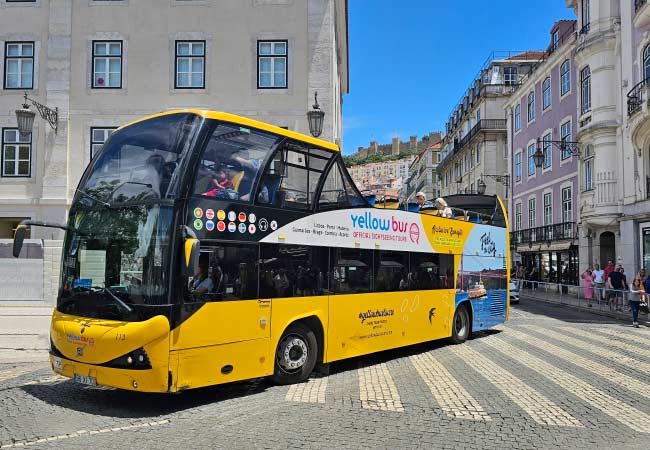
A Yellow Bus Tour company bus in the Praça da Figueira
When open-top tourist buses are the perfect choice for sightseeing
Hop-on, hop-off buses are a fantastic way to see Lisbon for certain types of tourists. They are ideal for slightly older or less mobile visitors who don't want to contend with Lisbon's steep hills, especially during the summer heat.
The tour buses are also great for time-critical visitors, such as cruise ship passengers who want to see as much as possible in a short period. Not only are the Lisbon tour buses more affordable than the excursions provided by cruise companies, but they also offer a convenient method to see the city.
The bus tours are an excellent activity for families with young children, providing a safe and engaging way to discover Lisbon's attractions while giving parents a well-deserved break from walking or entertaining.
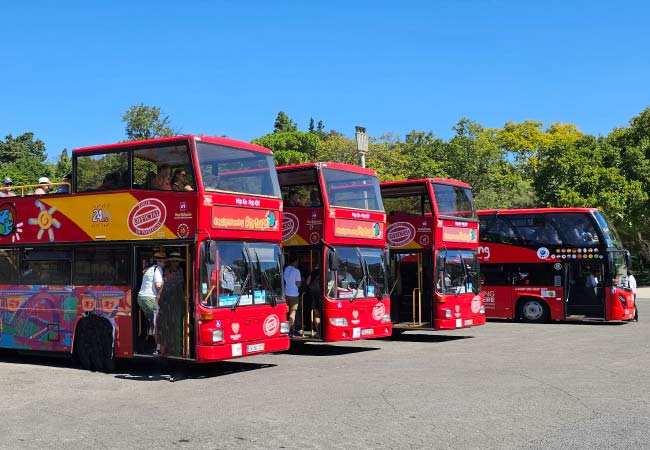
City-Sightseeing's buses at the Marques de Pombal hub
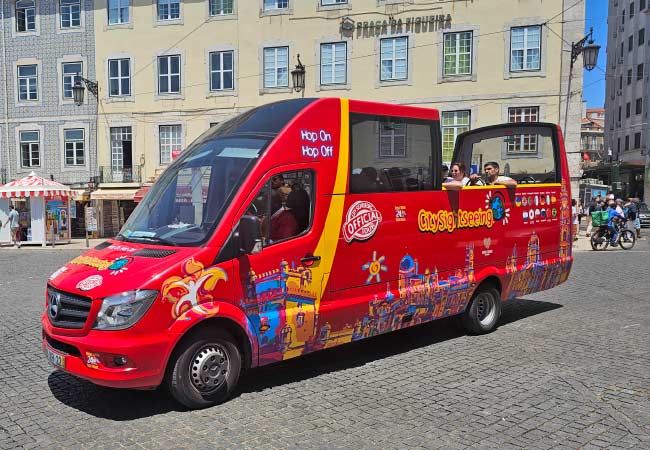
The small tour bus to around the arrow streets of Alfama
Getting the most from Lisbon’s hop-on, hop-off tour buses
• Hop-on hop-off tour buses are most beneficial during your initial days in Lisbon when you are still familiarizing yourself with the city. Once you have a basic understanding of the city's layout and main attractions, the buses become less useful for exploration and transportation.
• Tour buses can't replace the expertise of a knowledgeable guide, and the audio commentary on the buses often lacks depth. However, if you view the buses as a means to explore the city visually rather than expecting an in-depth educational experience, you'll thoroughly enjoy the ride.
• Before purchasing tickets, consider how long you really need them for. A 72-hour ticket may seem like good value, but often 24 hours is sufficient.
• To make the most of your hop-on hop-off experience, complete the entire bus route first, then decide which areas you'd like to explore further by exiting the bus.
• Remember that tickets are valid for 24-hour periods, so make sure to use them the following morning to get the most value from your purchase.
• To avoid being stranded, carefully check the schedule and note the time of the last bus. Additionally, pay attention to the departure frequency, as some routes only have a bus every 90 minutes, which may impact your plans.
• The complimentary headphones offered on the bus are often of poor quality, so it's best to bring your own for a better audio experience.
• While combined tickets can provide better value for money, it's important to only purchase the options you plan to use to avoid unnecessary expenses.
• When planning your itinerary, prioritise visiting Belem, located to the west of Lisbon, before exploring Parque das Nações in the north-east part of the city.
• Be aware of where the bus company's hub is located (the point where bus routes intersect). Yellow Bus's hub is at Praça da Figueira in central Lisbon (GPS: 38.713, -9.137 link to google maps). City Sightseeing and Cityrama are based further out, at the Marques De Pombal plaza (GPS: 38.725, -9.149).
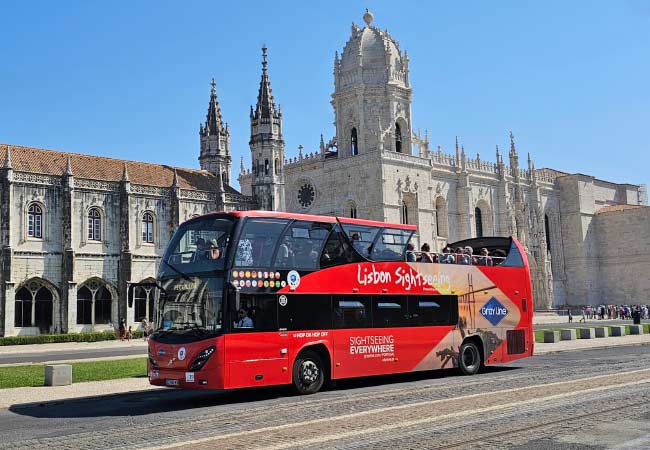
A City-Sightseeing bus passing the Mosteiro dos Jerónimos
The three hop-on, hop-off tour bus companies in Lisbon
With numerous online ticket agents offering a plethora of tour bus packages, choosing the right one for you can be overwhelming. However, there are three primary tour bus companies to consider:
• Yellow Bus Sightseeing Tours
• City Sightseeing
• Cityrama Gray Line
Yellow Bus Tours are run by Carristur, a subsidiary of Carris, the public transport operator of Lisbon. This means it has the prime hub in the centre of Lisbon at Praça da Figueira. In addition, it offers a historic tram tour (for an additional fee), and also has a boat (the Yellow Boat) which tours from Terreiro do Paço to Belém. Another benefit with Yellow Bus tickets is that you can ride the trams, funiculars, and the Santa Justa Lift for free during the validity period of your ticket.
Due to these extra benefits, we’d recommend Yellow Bus over the other two companies.
Yellow Bus provides two routes (‘Belem bus tour’ and ‘Modern Lisbon bus tour’), with the price dependent on the duration of the ticket and whether you also plan to use the tram or boat. A summary of their tours and prices are:
• € 22 - 24 hours unlimited use of the two tour bus routes
• € 38 - 48 hours unlimited use of the two tour bus routes and the historic tram
• € 38 - 48 hours unlimited use of the two tour bus routes and the boat (Terreiro do Paço to Belem)
• € 47 - 72 hours unlimited use of the two tour bus routes, the historic tram and the boat
We would recommend the 48-hour bus and tram ticket, as it includes unlimited use of the historic tram. This delightful red-painted tram follows the same route as the famous E28 tram, except you’ll have a seat and won’t be constantly having to worry about pickpockets.
The addition of the boat tour for an extra €9 is also good value. The Yellow Boat connects Terreiro do Paço (in the Baixa district) with the MAAT ferry terminal in Belem and passes beneath the 25th of April Bridge.
We personally prefer the smaller, traditional boats run by Nosso Tejo, but the Yellow Boat provides much better value.
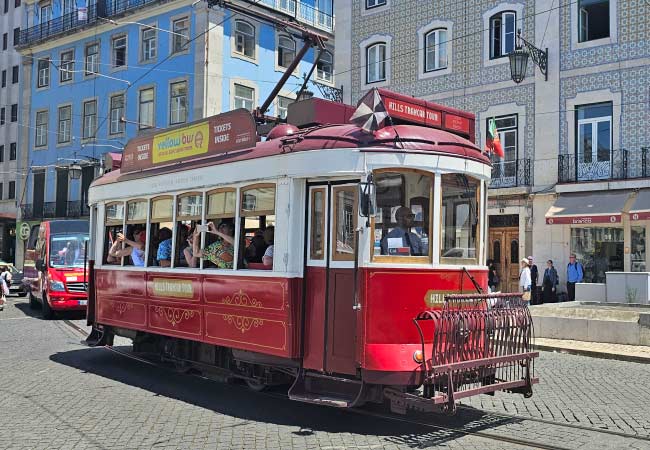
The historic tram
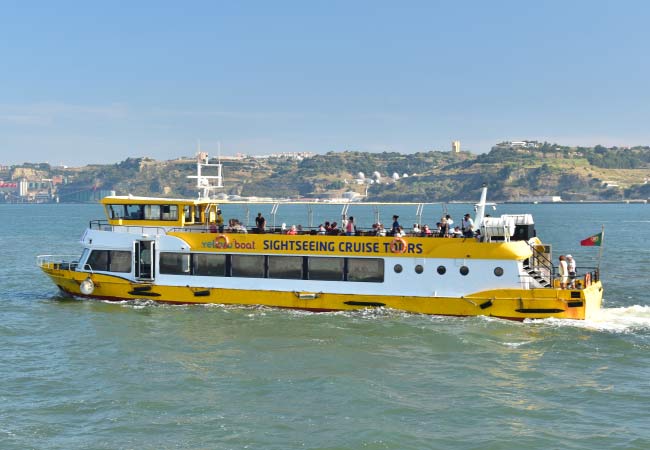
The Yellow Boat tour along the Tejo estuary
The two bus routes operated by Yellow Bus Tours are the "Belém bus tour" and the "Modern Lisbon bus tour".
The Belém route begins in the Praça da Figueira, and passes through the São Sebastião, Estrela, and Alcântara districts before following the Tejo Estuary to Belém. This is the much better route, and you will want to ride this route first.
The Modern Lisbon route departs from the Praça da Figueira goes around the edge of the Graça and Alfama districts, before heading to Parque das Nações. The return route follows one of Lisbon's main avenues (and much of the green metro line) but has much less to see.
A map of their routes can be downloaded from here
The tour operators may include routes to the castle or Alfama, but only small buses or trams can navigate these areas due to the narrow roads. During the summer, these specialist routes can become very crowded. The districts of Alfama and Baixa are best explored on foot, and in the time spent waiting for a tour bus or tram you could have already explored most of the district!
Hop-on, hop-off tourist bus routes in Lisbon
The next section details the main sights and attractions at each of the stops along the route. For this section, we have described the Carristur Yellow Bus routes, as this is the most popular tour company in Lisbon. Both City Sightseeing and Cityrama Gray Line have very similar routes with stops in the same areas.
Yellow Bus - Belém Lisbon open-top tourist route
This is the route to begin with. It heads north from central Lisbon, then westwards to the Belém district.
Praça da Figueira - Praça da Figueira is a vibrant square in central Lisbon, known for its historical significance and bustling atmosphere. Once the site of the Hospital de Todos os Santos, it now features an equestrian statue of Dom João I. Surrounded by traditional buildings, the square hosts a lively marketplace and is a key hub for public transportation and local cafés.
Restauradores: The Eden Theatre, regarded as the best example of Art Deco in Portugal, faces this square. The square also features a large monument commemorating Portugal’s independence from Spanish rule. From here, the funicular Elevador da Glória begins its slow ascent up the steep hill, providing a scenic ride and easy access to the Bairro Alto district.
Marquês de Pombal - The Marquês de Pombal is one of the main plazas in Lisbon, marking the top of the elegant Avenida da Liberdade and serving as a gateway to Lisbon's central districts. At its center stands a statue of the Marquês de Pombal, who redesigned Baixa after the devastating earthquake of 1755.
El Corte Inglés - Located in the Saldanha district of Lisbon, this upscale department store spans multiple floors, featuring everything from fashion and cosmetics to electronics and gourmet food.
Parque Eduardo VII - Named after the visit of King Edward VII of the UK to Lisbon in 1907, this expansive park offers a serene retreat in the city. The viewing platform at the top provides stunning views down the park and over historic Lisbon, including the Rossio and Baixa districts.
Amoreiras - The business district of Lisbon, featuring the distinctive Amoreiras Towers. These towers, while architecturally unique, are also home to the Amoreiras 360 Panoramic Viewpoint, which offers stunning views of the city.
Estrela - A charming stop that includes the 18th-century neoclassical Estrela Basilica, one of Lisbon’s most beautiful churches. The basilica’s grand dome and intricate interior make it a must see. Adjacent to the basilica is the Jardim da Estrela, a lovely public garden that offers a peaceful retreat with its manicured lawns, exotic plants and picturesque pond.
Pillar 7 and LxFactory - LxFactory is a vibrant, creative hub located in the Alcântara district of Lisbon. Housed in a former industrial complex, it has been transformed into a lively space filled with art studios, trendy boutiques, unique restaurants and eclectic shops. The area is known for its street art, which adds a dynamic and colourful backdrop to the historic buildings.
Belem Museu dos Coches - The first stop in Belém is the Museu dos Coches (National Coach Museum), a fascinating museum that showcases one of the finest collections of royal carriages in the world. Housed in the former Royal Riding School, the museum displays beautifully ornate coaches, carriages and ceremonial vehicles dating from the 16th to the 19th centuries.
Mosteiro dos Jerónimos - The grand monastery built on the site where Vasco da Gama spent his last night before his momentous voyage to India. This UNESCO World Heritage site is a masterpiece of Manueline architecture, with its elaborate stone carvings and stunning cloisters. This stop is just outside the famous Pastéis de Belém, the home of Lisbon’s renowned custard tart. It's a great place to enjoy a bica (strong coffee) along with these delicious pastries.
Torre de Belém - This iconic tower, a UNESCO World Heritage site, is a symbol of Portugal's Age of Discovery. Built in the early 16th century, it offers stunning views of the Tagus River. The tower's intricate Manueline design and historical significance make it a must-visit landmark. Its strategic location at the river’s edge once guarded the entrance to the city.
Docas Cruise Terminal - The trendy bar and restaurant district near the Ponte 25 de Abril bridge, known for its vibrant nightlife. The docks come alive in the evenings as people flock to the area’s plethora of bars and restaurants.
Avenida da Liberdade - Avenida da Liberdade is an elegant, tree-lined avenue and one of Lisbon’s most prestigious streets, known for its luxury shops, theatres and historic buildings. Stretching for over a kilometre, the avenue's wide sidewalks, dotted with fountains and statues, make it a delightful place for a leisurely stroll or people watching.
Yellow Bus - Modern Lisbon tour
This route heads around the edge of Graça and Alfama, on roads that are suitable for the tour bus, before following the Tejo northwards to the Parque das Nações.
Praça da Figueira - Same stop as the Belém Lisbon route
Restauradores - Same stop as the Belém Lisbon route
Avenida da Liberdade - Same stop as the Belém Lisbon route
Lisbon Cruise Terminal - This is the stop for Alfama. Alfama, Lisbon's oldest district, is a charming labyrinth of narrow cobblestone streets, colourful houses and historic landmarks. This vibrant neighbourhood, which survived the great earthquake of 1755, is home to the iconic São Jorge Castle and the Lisbon Cathedral. The district's steep, winding alleys are filled with traditional Fado houses, quaint cafés and vibrant street art. Alfama's unique character and historical significance make it a must-visit area.
Museu do Azulejo - A museum focusing on the tradition of painted tiles, known as azulejos. Housed in the former Madre de Deus Convent, it showcases the history and art of tile-making from the 15th century to the present. The museum's collection includes stunning examples of decorative tiles, illustrating their significance in Portuguese culture.
Beato - A lesser-known neighbourhood in eastern Lisbon that is currently experiencing a remarkable transformation. Once an industrial area, Beato is now becoming a hub for innovation, creativity and entrepreneurship. The iconic Beato Convent has been converted into a thriving startup incubator, attracting tech companies and young professionals. This is where Lisbon’s artisan scene is based.
Oceanário de Lisboa - One of Europe's largest aquariums, which is located in the Parque das Nações district. The massive central tank, representing the open ocean, is surrounded by distinct habitats showcasing the biodiversity of different ocean ecosystems.
Vasco da Gama Shopping - This is the stop for exploring the Parque das Nações. The Parque das Nações, a modern district in Lisbon, was redeveloped for the 1998 World Expo. This vibrant area features contemporary architecture, lush green spaces and a scenic waterfront. Its blend of modernity and natural beauty provides a refreshing contrast to Lisbon’s historic neighbourhoods.
Torre Vasco da Gama - Torre Vasco da Gama, a 145-metre tall observation tower in Parque das Nações, offers panoramic views of Lisbon and the Tagus River. This is the tallest building in Lisbon and is named after explorer Vasco da Gama.
Are the hop-on, hop-off buses good value?
The hop-on, hop-off buses have their flaws, but are one of the better-value tourist activities in Lisbon. There are many options for bus tickets, but a typical 24-hour ticket costs around €23 and offers significantly better value than the tuk-tuk tours. A 90-minute tuk-tuk tour of central Lisbon costs around €90, while a tour to Belém can exceed €120.
However, the tour buses are not as cost-effective when compared to public transport. A single metro ticket costs €1.90, and a 24-hour public transport ticket is just €7.00. This 24-hour ticket is exceptional value as it includes access to the number 28 tram, the Elevador de Santa Justa and the Elevador da Glória. This means you can experience three of Lisbon’s iconic modes of transport within the price of a single ticket.
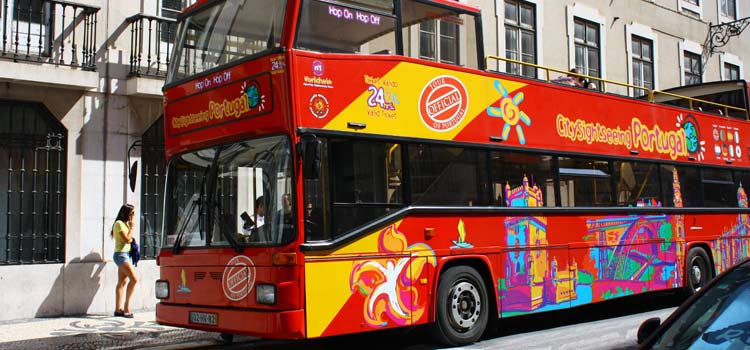
A City Sightseeing tour bus
Tour bus routes and extra options or upsells
All three hop-on, hop-off bus companies have two basic routes and a series of additional upsells and add-ons. Each company offers a primary route from central Lisbon west to Belém and a secondary route covering the eastern and northern sides of the city. The tour to the west and Belém should always be the first route taken.
The bus tours to the northern and eastern sides of Lisbon visit the ultra-modern Parque das Nações, but there can be long stretches with not much to see. These routes have fewer stops where you'll want to get off, so it’s often better to remain on the bus for the entire route.
Discover more of Lisbon with our most popular guides
If you've found our content valuable, we'd welcome your support.
The digital publishing landscape has evolved significantly. As a small independent publisher, we face growing challenges. Search engines increasingly favour paid content over organic results, while AI-generated content often reproduces original work without attribution.
To support our work, please consider bookmarking this page (press Ctrl + D) for quick access. If you find an article helpful, we'd be grateful if you'd share it with friends on social media.
For specific questions, please see our Reddit community at r/LisbonPortugalTravel.
Should you notice any outdated or incorrect information, please contact us at [email protected]
Thank you for helping us continue to provide valuable content in an increasingly challenging digital environment.
A complete list of all of our Lisbon articles
If you've found our content valuable, we'd welcome your support.
The digital publishing landscape has evolved significantly. As a small independent publisher, we face growing challenges. Search engines increasingly favour paid content over organic results, while AI-generated content often reproduces original work without attribution.
To support our work, please consider bookmarking this page (press Ctrl + D) for quick access. If you find an article helpful, we'd be grateful if you'd share it with friends on social media.
For specific questions, please see our Reddit community at r/LisbonPortugalTravel.
Should you notice any outdated or incorrect information, please contact us at [email protected]
Thank you for helping us continue to provide valuable content in an increasingly challenging digital environment.


































